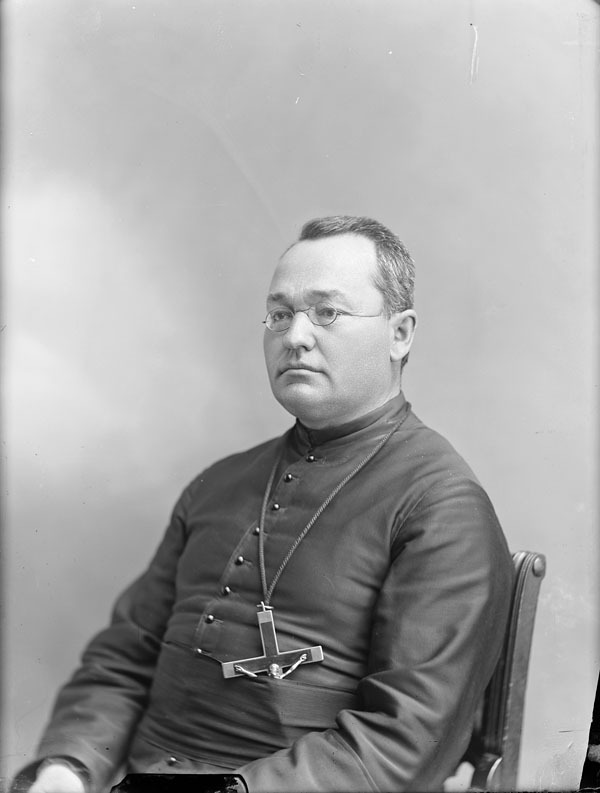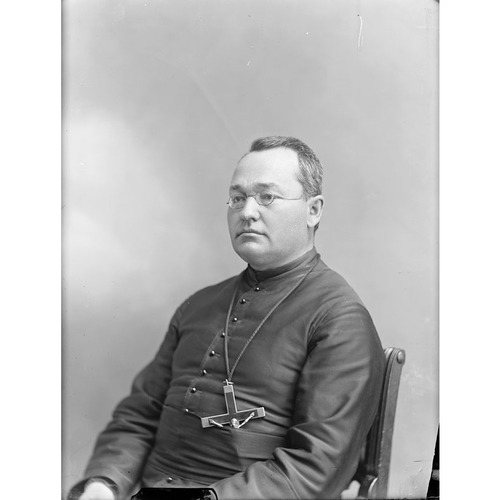GENDREAU, EDMOND, Roman Catholic priest, Oblate of Mary Immaculate, missionary, and administrator; b. 3 April 1840 in Saint-Pie, Lower Canada, son of Pierre Gendreau, a blacksmith, and Adelaïde Normandin; d. 11 Sept. 1918 in Cap-de-la-Madeleine, Que.
After completing his classical and theological studies at the Séminaire de Saint-Hyacinthe, Edmond Gendreau was ordained priest on 5 Oct. 1862 by Bishop Joseph La Rocque* of Saint-Hyacinthe. He was only 22 and the minimum age for ordination was 24, but he had been given a dispensation because of his considerable talents and the shortage of priests. At the seminary Gendreau had heard a lecture by Bishop Alexandre-Antonin Taché* of St Boniface and had begun to dream of working in the Indian missions of the North-West. After his ordination he wanted to fulfil his dream, and even made arrangements with Taché, but the bishop of Saint-Hyacinthe, who badly needed clergy and thought highly of this promising new recruit, made him postpone his evangelistic plans and appointed him a missionary to the Eastern Townships.
Serving first as assistant priest at Saint-Thomas, in Compton Township, Father Gendreau later had to minister to the surrounding townships of Clifton, Auckland, Hereford, and Barford as well. In 1864 he was appointed curé of Saint-François-Xavier and given charge of Saint-Joachim, in Shefford Township. The following year he became the first resident priest of Saint-Bernardin (in Waterloo) and ministered to Knowlton in addition. From 1868 to 1874 he was curé of Saint-Camille (in Cookshire) and also served Bury. It was from Bury that he began in 1871 to direct a colonization movement in the townships of Ditton, Chesham, and Emberton. In 1873 the government of Canada appointed him a special agent responsible for visiting French Canadians who had emigrated to the United States and for making recommendations to facilitate their repatriation. He obtained grants from Ottawa enabling him to bring back 300 families. During his 18 years in the Eastern Townships Father Gendreau built chapels, churches, and presbyteries. A friend to all, he was considered “one of the most influential men in the region.” In 1874 the Séminaire de Saint-Hyacinthe, faced with financial difficulties, appointed him its procurator, calling on his administrative talents. In the space of a few years Gendreau rectified the situation. The building was transformed inside and out: heating, water system, lighting, library, portico, floors, and chapel were all inspected, improved, or built.
In 1880, after he had finished his assignment at the seminary, Gendreau’s desire to go out to the North-West missions came to the fore again. His bishop, Louis-Zéphirin Moreau*, approved his plan to enter the noviciate of the Oblate fathers and encouraged him, while reminding him that should he find he had not been called by God to this vocation, he could return to his diocese and would be “treated like a son in his father’s house.” Gendreau entered the Oblates’ noviciate in Lachine on 5 Dec. 1880 and took his final vows on 8 Dec. 1881. However, his dream of becoming a missionary was postponed once again, since the Oblates were in urgent need of good administrators. After spending a year as bursar at the noviciate in Lachine, he was appointed procurator at the College of Ottawa, where he remained from 1882 until 1891. During this time he added a large annex to the building and erected a splendid chapel and a spacious theatre. He also oversaw the construction of the Saint-Joseph scholasticate in Archville (Ottawa East) and laid the groundwork for the church of Sacré-Cœur in Ottawa.
Gendreau’s zeal was not confined to the capital, however. The Oblates were engaged at the time in a colonization project in the Timiskaming region. One of their lay brothers, Joseph Moffet, had started a project in Ville-Marie. He needed support from a man of some stature, skilled in organizing, to set up structures that could ensure its development. The ideal person for the job was Gendreau, whose stay in the Eastern Townships had given him just the right experience. In 1884 the Société de Colonisation du Témiscamingue was founded in the diocese of Ottawa and Gendreau became its president and leading spirit. He began by establishing communications by land and by water. In 1887, through the assistance of John Henry Pope*, the minister of railways and canals, he got the federal government to set up the Lake Temiscamingue Railway Company, and he was named its president. The colonization society was highly successful and, according to Arthur Buies*, there was nothing comparable to it except the work of curé François-Xavier-Antoine Labelle*.
At the same time, Oblate missionaries in the west were struggling with harassment by agents of the federal government, which was undermining the rights of the missionaries and of the Indians themselves. Bishop Vital-Justin Grandin* of St Albert (Alta), Father Albert Lacombe, and others appealed to Gendreau, as procurator of the College of Ottawa, to support them in demanding their rights from the federal government. In 1888 Prime Minister Sir John A. Macdonald* offered to send Gendreau to conduct an inquiry among the Indians in order to ascertain the legitimacy of their complaints against the government agents. Gendreau confirmed the truth of the missionaries’ allegations and wanted to present a written memorandum to the government, but it saw fit to authorize only an oral report, which, for all practical purposes, brought no results.
After the College of Ottawa, it was the turn of the Oblates’ provincial administration to enlist Gendreau’s services by appointing him provincial bursar, a post he held from 1891 to 1893. He lived in Montreal during that time, and served also as agent for the bishops of the North-West in their dealings with the Canadian government. From 1893 to 1898 he was in Mattawa, Ont., as superior and curé. While he was there, Gendreau displayed the greatest dedication and earned the esteem of the parishioners, who unanimously requested that he stay and deeply regretted his departure.
Father Gendreau spent a short time in the parish of Notre-Dame-de-Grâce in Hull, Que., before being given new responsibilities. The Klondike gold-rush was on, and the Jesuit missionaries in Alaska had undertaken ministry to the many prospectors in the Yukon region. When a federal government inquiry showed that the Klondike was part of the North-West Territories, the vicar apostolic of Athabaska-Mackenzie, Émile-Jean-Baptiste-Marie Grouard, had to pay attention to the territory, which fell under his jurisdiction. In 1898 he asked Gendreau to serve as vicar general and superior of the Yukon missions. Gendreau moved to Dawson, and for five years he devoted his talents and enthusiasm to organizing a region into which prospectors were flooding from all over the world. Substandard living conditions affected his health, however, and problems with his eyesight forced him to end his work in the Yukon.
From 1902 to 1913 Gendreau carried on a diversity of ministries in Kenora, Ont.; at St Mary’s Academy and Misericordia Hospital in Winnipeg; and in St Charles, Man. Finally, exhausted, he had to abandon all his activities. He asked permission to end his days in Cap-de-la-Madeleine, Que. Blind and paralysed, Edmond Gendreau spent the last years of his life confined to his room, his pen unused and his breviary unopened. He died in 1918, after a varied and highly productive career distinguished by keen enthusiasm, great generosity, and exemplary unworldliness. Fluently bilingual, a competent administrator, and a skilful diplomat, he was remembered, wherever he went, as an engaging personality and a man devoted to his church and to people.
Arch. Deschâtelets, Oblats de Marie-Immaculée (Ottawa), Dossier Gendreau; HE 1981.L27L, no.52 (Augustin Gaudet à Adélard Langevin). Arch. des Oblats de Marie-Immaculée (Montréal), Codex historicus; Corr., J.-E. Antoine à Edmond Gendreau, 25 juin 1892; L.-Z. Moreau à Gendreau, 29 nov. 1880. Arch. Générales des Oblats de Marie-Immaculée (Rome), Corr., G LPP 2048 (Adélard Langevin à Louis Soullier, 31 juill. 1893); 2088 (Langevin au vicaire général, 19 févr. 1898); 2120 (Langevin à Cassien Augier, 14 juin 1900). J.-B.-A. Allaire, Dictionnaire biographique du clergé canadien-français (6v., Montréal et Saint-Hyacinthe, Qué., 1908–34). Arthur Buies, L’Outaouais supérieur (Québec, 1889). Gaston Carrière, Dictionnaire biographique des oblats de Marie-Immaculée au Canada (4v., Ottawa, 1976–89), 2: 75–77. “Feu le R.P. Edmond Gendreau, o.m.i., ancien curé de Kénora et de Saint-Charles,” Les Cloches de Saint-Boniface (Saint-Boniface, Man.), 17 (1918): 246–49. Athanase Francœur et al., Notices nécrologiques de la province du Canada-est (15v., Ottawa, 1957–90), 2: 138–39. Arthur Joyal, “Le Rév. Père E. Gendreau, o.m.i.,” Annales du T.S. Rosaire (Cap-de-la-Madeleine, Qué.), 3e sér., 3 (1918): 420–26, also published as Annales de Notre-Dame du Cap, 3e sér., 4 (1919): 21–26. “Jubilé d’or sacerdotal du R.P. Edmond Gendreau, o.m.i.,” Les Cloches de Saint-Boniface, 11 (1912): 309–15. Missions de la Congrégation des missionnaires oblats de Marie Immaculée (Paris), 24 (1886): 322–29; 31 (1893): 355–58; 37 (1899): 118–21, 219–48; (Rome) 65 (1931): 229–33.
Cite This Article
Romuald Boucher, “GENDREAU, EDMOND,” in Dictionary of Canadian Biography, vol. 14, University of Toronto/Université Laval, 2003–, accessed December 31, 2025, https://www.biographi.ca/en/bio/gendreau_edmond_14E.html.
The citation above shows the format for footnotes and endnotes according to the Chicago manual of style (16th edition). Information to be used in other citation formats:
| Permalink: | https://www.biographi.ca/en/bio/gendreau_edmond_14E.html |
| Author of Article: | Romuald Boucher |
| Title of Article: | GENDREAU, EDMOND |
| Publication Name: | Dictionary of Canadian Biography, vol. 14 |
| Publisher: | University of Toronto/Université Laval |
| Year of publication: | 1998 |
| Year of revision: | 1998 |
| Access Date: | December 31, 2025 |




